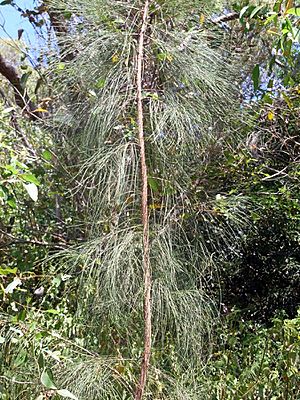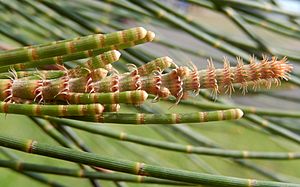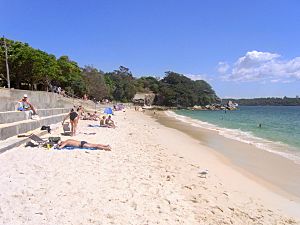Nielsen Park she oak facts for kids
Quick facts for kids Nielsen Park she oak |
|
|---|---|
 |
|
 |
|
| Conservation status | |
| Scientific classification | |
| Genus: |
Allocasuarina
|
| Species: |
portuensis
|
The Nielsen Park she-oak (Allocasuarina portuensis) is a super rare plant. It grows only in Sydney, Australia. This plant can be a small shrub or a slender tree. It can grow up to 5 meters (about 16 feet) tall.
Contents
About the Nielsen Park She-Oak
What Does It Look Like?
This special plant has green, drooping branches. These branches can be up to 27 centimeters (about 10.5 inches) long. The Nielsen Park she-oak is a dioecious plant. This means that male and female flowers grow on separate plants.
Its cones are about 1.2 to 1.5 centimeters (0.5 to 0.6 inches) long. They are also about 0.8 to 1 centimeter (0.3 to 0.4 inches) wide. These cones sit on small stalks that are 0.2 to 1.5 centimeters long.
Discovery and Name
A park ranger named Peter Brookhouse first found this plant. He worked at Sydney Harbour National Park. In 1989, a scientist named Lawrie Johnson officially described it.
The plant's scientific name, portuensis, comes from Latin. It means "inhabiting a port." This is because the plant was first found near Port Jackson in Sydney. It looks a lot like two other she-oak plants: Allocasuarina rigida and A. distyla. Scientists can tell them apart by looking at their male flowers.
Where Does It Live?
The Nielsen Park she-oak was first found in 1986. Ten plants were discovered at Nielsen Park in Sydney's eastern suburbs. Sadly, those original plants have now died.
The plant used to grow in forests. These forests had sandy soil. Tall trees like Port Jackson fig (Ficus rubiginosa), smooth-barked apple (Angophora costata), and blueberry ash (Elaeocarpus reticulatus) grew there. Smaller plants like Pittosporum revolutum and Kunzea ambigua were also part of its home. We don't know how far it used to spread. This is because much of the nearby bushland has been cleared.
Saving This Rare Plant
Even though the first plants died, people started working to save the species. They began growing new plants from seeds and cuttings. These new plants were then planted in different spots. They were placed around Nielsen Park and nearby areas like Gap Bluff and Hermit Point. By the year 2000, 54 of these planted she-oaks were still alive. Efforts continue to protect this very rare Australian plant.



